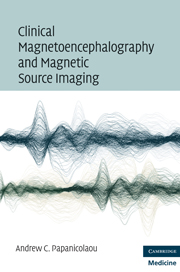Book contents
- Frontmatter
- Contents
- Contributors
- Preface
- Section 1 The method
- 1 Basic concepts
- 2 The nature and origin of magnetic signals
- 3 Recording the magnetic flux
- 4 Overview of MSI using the single equivalent current dipole (ECD) model as an example
- 5 The fundamental problems of MSI
- 6 Head models
- 7 Source models – discrete source models
- 8 Source models – distributed source models
- 9 Source models – beamformers
- 10 Pragmatic features of the clinical use of MEG/MSI
- Section 2 Spontaneous brain activity
- Section 3 Evoked magnetic fields
- Postscript: Future applications of clinical MEG
- References
- Index
9 - Source models – beamformers
from Section 1 - The method
Published online by Cambridge University Press: 01 March 2010
- Frontmatter
- Contents
- Contributors
- Preface
- Section 1 The method
- 1 Basic concepts
- 2 The nature and origin of magnetic signals
- 3 Recording the magnetic flux
- 4 Overview of MSI using the single equivalent current dipole (ECD) model as an example
- 5 The fundamental problems of MSI
- 6 Head models
- 7 Source models – discrete source models
- 8 Source models – distributed source models
- 9 Source models – beamformers
- 10 Pragmatic features of the clinical use of MEG/MSI
- Section 2 Spontaneous brain activity
- Section 3 Evoked magnetic fields
- Postscript: Future applications of clinical MEG
- References
- Index
Summary
In general, a beamformer is a spatial filter that combines linearly the output of an array of sensors in order to enhance a signal relative to background noise. In the context of MEG inverse-problem solutions, for each time point, the external field measurements are combined so that the activity of only one current source is maximized, while contributions from all other sources are minimized. A beamformer allows signals of interest to pass through each volume-grid node, or cortical surface location, while suppressing noise (unwanted signals) from other locations.
While the current source estimate provided by minimum-norm solutions accounts for the complete magnetic field signal measured, beamformers are designed as filters that are matched to – focused on – a specific target location. The parameters of these spatial filter functions may be selected to optimize certain properties of the current sources, such as location, stability, or resolution. A spatial filter assigns a weight to each sensor reading, and then combines these weights with the measured signal to estimate the source strength at a predetermined target location and orientation. Beamformers may be either adaptive or nonadaptive, depending on whether or not their parameters are based on the statistical properties of the recorded data. Nonadaptive beamformers use a fixed set of weights to combine the signals from the sensors in the array, primarily using only information about the location of the sensors in space and the wave directions of interest. In contrast, adaptive beamforming techniques generally combine this information with properties of the signals actually received by the array, typically to improve rejection of unwanted signals from other directions.
- Type
- Chapter
- Information
- Publisher: Cambridge University PressPrint publication year: 2009



